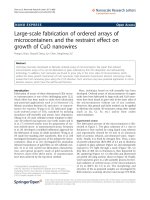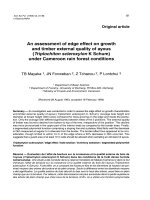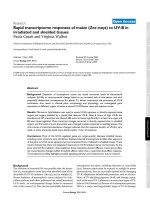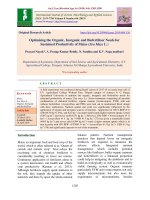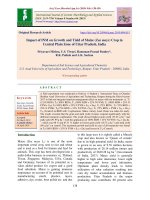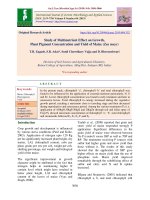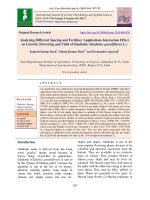Study of multinutrient effect on growth, plant pigment concentration and yield of maize (Zea mays)
Bạn đang xem bản rút gọn của tài liệu. Xem và tải ngay bản đầy đủ của tài liệu tại đây (514.18 KB, 11 trang )
Int.J.Curr.Microbiol.App.Sci (2019) 8(4): 3056-3066
International Journal of Current Microbiology and Applied Sciences
ISSN: 2319-7706 Volume 8 Number 04 (2019)
Journal homepage:
Original Research Article
/>
Study of Multinutrient Effect on Growth,
Plant Pigment Concentration and Yield of Maize (Zea mays)
T.R. Zagade, S.R. Adat*, Sunil Chowdhary Vajja and D. Bhuvneshwari
Division of Soil Science and Agricultural Chemistry,
Ratnai College of Agriculture, Akluj.Dist.-Solapur (MS, India)
*Corresponding author
ABSTRACT
Keywords
Maize, Chlorophyll,
Plant pigment,
Yield
Article Info
Accepted:
28 March 2019
Available Online:
10 April 2019
In the present study, chlorophyll ‘a’, chlorophyll ‘b’ and total chlorophyll was
found to be influenced by the application of essential nutrients particularly, N, S
and Fe. Lower chlorophyll concentration was found in early immature and later at
senescence leaves. Total chlorophyll in canopy increased during the vegetative
growth period, reaching a maximum close to tasseling stage and then decreased
during reproductive and senescence period. Among the various treatments (F5) i.e.
application of 100kgN,50kgP,30kgS and 20kgZn through soil and foliar spray of
Fe@2% showed maximum concentration of chlorophyll ‘a’, ‘b’, total chlorophyll
and carotenoids followed F4, F3, F2, F1 and F0.
Introduction
Crop growth and development is influenced
by various stress conditions (Patil and Kolte,
2003). Application of nitrogen upto 120 Kg
per ha significantly increased plant height, dry
matter, LAI, chlorophyll content, cobs per
plant, grains per row per cob, weight per cob,
shelling percentage, test weight and biological
yield of the maize.
The significant improvement in growth
character might be attributed to the fact that
nitrogen helps in maintaining higher N
contain level which might have resulted in
better plant height, LAI and chlorophyll
content of the leaves of maize (Vyas and
Singh, 2000).
Taalab et al., (2008) reported that grain and
straw yield of maize responded strongly P
application. Significant differences in the
grain yield of maize were observed between
No P (control) versus SSP as well as TSP and
RP. The treatments receiving P sources with
sulfur had higher grain and straw yield than
those without it. The results of this study
showed that the application of SSP gave
higher effects on maize yield than the use of
phosphate rock. Maize yield improved
remarkably through the solubilizing effect of
sulfur and citric acid N and K uptake
increased.
Biljana and Stojanovic (2005) indicated that
chlorophyll a, b, and total chlorophyll (chl
3056
Int.J.Curr.Microbiol.App.Sci (2019) 8(4): 3056-3066
a+b) and carotenoid (carotenes and
xanthophylls) content depended on the
presence and ratio of mineral elements in the
substrate. The variant of fertilization with N
and P turned out to be most favorable. The
next most favorable variant was the one with
nitrogen alone, and it was followed by the
variant with N and K. The greatest
chlorophyll content in plants occurs at the
outset of the flowering phase. Thus, the
content of chlorophyll content and levels of
other leaf biochemical constituents can be
used as indicators of crop stress under
conditions of nutritional deficiencies.
Application of mineral fertilizers also
promotes better utilization of assimilates in
metabolic and growth processes.
Potassium @ 50 kg K2O ha-1 for all six
treatments and full quantity of phosphorus as
per treatments was applied at the time of
sowing. Nitrogen was applied in two splits.
Two iron sprays @ 2% Fe were given one at
silking stage and another at cob development
stage.
Results and Discussion
Effect of fertility levels on growth
parameters and grain yield of maize
In the present investigation, observations
were recorded on height, leaf area index, total
biomass and economic yield.
Effect of fertility levels on plant height
Materials and Methods
It was aimed to study the relationship between
plant pigments and spectral reflectance and
leaf nutrient concentration. In order to meet
the objectives of the project, a field
experiment was laid out (Fig. 3) in
Randomized Block Design using maize as a
test crop. There were six fertility treatments
as detailed below replicated in to four.
Fertility levels (six)
F0 No fertilizer application
F1 Only N (100 kg N ha-1)
F2 N + P (100 kg N ha-1 + 50 kg P2O5 ha-1)
F3 N + P + S (100 kg N ha-1 + 50 kg P2O5
ha-1 + 30 kg S ha-1)
F4 N + P +S + Zn (100 kg N ha-1 + 50 kg
P2O5 ha-1 + 30 kg S ha-1 + 20 kg ZnSO4 ha-1
F5 N + P + S + Zn + Fe (100 kg N ha-1 + 50
kg P2O5 ha-1 + 30 kg S ha-1 + 20 kg ZnSO4 ha1
+ 2 % Fe foliar spray at 2 crop growth stages
i.e. Silking and cob development)
The recommended dose of fertilizer for
irrigated maize under Marathwada condition
is 10:50:50 kg N, P2O5 and K2O ha-1.
The height of maize was monitored
throughout growth period of the crop.
Periodical observations recorded on various
dates under various fertility level treatments
are presented in Table 1. It was evidenced that
in first phase of crop, growth rate was rather
slow and results were non significant due to
application of various treatments. However
after 51 DAS, the treatments showed
significant differences. Treatment F3, F4 and
F5 showed significant increase in height over
F2, F1 and F0. Further, it was also observed
that there was continuous increase in plant
height throughout growth period of crop due
to each additional nutrient (93.78 cm in F0 to
123.5 95 cm in F5). Each incremental level of
nutrient recorded increase in the height of
maize. Application of N100+P50+S30+Zn20
and foliar spray of 2% Fe at 2 stages (F5
treatment) significantly increased plant height
to the extent of 232.5 cm (109 DAS) and this
was the maximum height attained by maize
crop. Results showed that F5 (N+P+S+Zn
+Fe@ 2% foliar spray) treatment was superior
over rest, followed by F4 (N+P+S+Zn,
F3(N+P+S), F2(N+P) and F1 (only N).
3057
Int.J.Curr.Microbiol.App.Sci (2019) 8(4): 3056-3066
In depth scrutiny of data effect of
multinutrient application on height of maize
showed that was increased at higher rate up to
70 DAS.
Effect of fertility levels on leaf area index
Leaf area is one of the important attributes
that influences the growth and development
of crop. Therefore, the measurement on leaf
area was carried out in all possible
observations during the growth cycle of maize
crop. On an average increase in leaf area
index was from 0.014 to 3.50 from 18 to
109days old crop. Similarly, the application
of each additional nutrient had influence on
leaf area index of maize. Maize receiving all
deficient nutrients through F5 (NPSZnFe)
treatment had profound influence on leaf area
which was increased nearly by 50% or more
over rest of the treatments. Addition of
nitrogen, phosphorus, sulphur and zinc to soil
and foliar sprays of iron increased the leaf
area index. There was boost in leaf area index
after 51 DAS. This period coincides with top
dressing of maize with remaining dose of
nitrogen and increase in bright sunshine
hours.
It was very clear from the data that F5
treatment had significantly higher leaf area
over rest of the treatments particularly from
32 DAS to last observation. Treatment F2 to
F4 had significantly higher leaf area over
control. Similar findings were reported by
Jawale (2009).
From Fig. 2 and 3, it was observed that
biomass per plant (g plant-1), total biomass
per hectare(q ha-1) and Grain yield per hectare
(q ha-1) responded strongly to F5
(N+P+S+Zn+Fe@ 2% foliar spray) followed
by F4 (N+P+S+Zn), F3 (N+P+S), F2 (N+P) and
F1(Only N). It was also noticed that biomass
(g plant-1) and total biomass (q ha-1) increased
with the advancement of crop growth and it
was maximum in F5 treatment (complete
nutrient package). From both figures 2 and 3,
it was noticed that the amount of biomass
accumulation of maize significantly increased
with increasing plant age in every treatment
.However F5 treatment was superior over rest
of the treatments. Results indicated that,
application of N, P, S, Zn through soil and Fe
through foliar spray at silking and cob
development stage gives higher yield. Kayoed
et al., (2005) ascribed that other nutrient
besides N, P and K affect the yield of maize.
Therefore, the inclusion of other nutrients
besides N, P and K in the fertilizer
recommendation for maize should be
encouraged.
Effect of fertility levels on total biomass
and economic yield
The total biomass and economic yield of
maize (grain yield) under various fertility
levels are presented in Table 3 and showed in
Figure 2 and Figure 3. The data indicated the
periodical increase in total biomass of maize.
The average increase in biomass recovery was
from 1.09 g plant-1 to 176.83 g plant-1 within
91 days. Influence of fertility levels was
recognizable and seen in the data presented in
the Table 3 and Fig. 2. On an average lowest
biomass of 0.79 g plant-1 was recorded in
control treatment at 18 DAS which was
increased upto 221.0 g plant-1 at 109 DAS in
the treatment received additional nutrient
application (F5). The accumulation of biomass
was relatively more at 109 DAS, this may be
attributed to the productive phase of the
maize. At all growth observations, application
of each additional nutrient produced higher
biomass. The biomass production under
treatment F5 (100:50:30:20 N, P2O5, S, ZnSO4
kg ha-1 respectively), with two iron sprays (at
51 and 73 DAS) produced maximum biomass.
It was also evidenced that when sulphur was
added to soils, there was marked increase in
3058
Int.J.Curr.Microbiol.App.Sci (2019) 8(4): 3056-3066
biomass accumulation (139 g plant-1 to 193 g
plant-1) at 109days of maize. This response of
maize to sulphur application indicates that
sulphur is becoming deficient in growing
media and warns that due care must be taken
in further fertilizer application programmes.
Among the two micronutrients, foliar spray of
iron contributed more to the growth of maize
as compared to zinc application. There was 8
g per plant increase in biomass due to
application of ZnSO4 (F4) whereas foliar
spray of Fe has 20 g per plant biomass
increase. This might be because of highly
calcareous nature of soil, which reduced the
soil iron availability and hence crop
responded to foliar application of iron.
Further scrutiny of data of Table 3 revealed
that the total biomass and grain yield was
lowest (224.42 and 70.4 q ha-1, respectively)
in unfertilized plot while yield was improved
in nutrient added plots. The total biomass and
grain yield increased in N applied treatment
was 10.90 q ha-1 and 0.28 q ha-1. In addition
to N when P was applied the biomass and
grain yield was increased to the level of
265.10 q ha and 84.8 q ha-1, respectively. It
was noted in the present investigation that in
addition to N and P when sulfur was added
there was sharp elevation in total biomass and
grain yield. The additional application of zinc
and iron further increased the total biomass
and grain yield. Among the two
micronutrients applied, spraying of iron
contributed more in respect of total biomass
and grain yield, which was to the tune of
300.64 and 96.08 q ha-1. These results showed
that foliar sprays of iron satisfied the iron
hunger of plant.
From Fig. 2 and 3, it was observed that
biomass per plant (g plant-1), total biomass
per hectare(q ha-1) and Grain yield per hectare
(q ha-1) responded strongly to F5
(N+P+S+Zn+Fe@ 2% foliar spray) followed
by F4 (N+P+S+Zn), F3 (N+P+S), F2 (N+P) and
F1(Only N). It was also noticed that biomass
(g plant-1) and total biomass (q ha-1) increased
with the advancement of crop growth and it
was maximum in F5 treatment (complete
nutrient package). From both figures 2 and 3,
it was noticed that the amount of biomass
accumulation of maize significantly increased
with increasing plant age in every treatment
.However F5 treatment was superior over rest
of the treatments. Results indicated that,
application of N, P, S, Zn through soil and Fe
through foliar spray at silking and cob
development stage gives higher yield. Kayoed
et al., (2005) ascribed that other nutrient
besides N,P and K affect the yield of maize.
Therefore, the inclusion of other nutrients
besides N, P and K in the fertilizer
recommendation for maize should be
encouraged.
The results interpreted in above paragraphs on
various growth parameters viz., height of
plant, number of leaves, leaf area index
(LAI), total biomass per plant, total biomass
per hectare at harvest and grain yield of maize
revealed that all the listed growth parameters
and yield were found to be improved due to
each additional nutrient viz., N, P, S, Zn and
Fe. The height of plant significantly improved
after 32 DAS in all the treatments. This may
be because of top dressing of remaining dose
of nitrogen which was applied to maize at 21
DAS. Further, it was also noticed that
application of N, N + P, N + P + S, N + P + S
+ Zn, N + P + S + Zn + Fe significantly
increased height of maize over control. Petkar
(2004), Bodkhe (2008), Jawale (2009) and
Zagade and Patil (2011) recorded increase in
height and growth parameters of maize due to
application of nitrogen. Even though the rate
of increase of height of fertilized crop was
always higher than the control plot at all
observations. The increase of height was at its
lower magnitude till 18 DAS. The treatment
differences
were
broadened
with
advancement of age of crop at 70 and 109
3059
Int.J.Curr.Microbiol.App.Sci (2019) 8(4): 3056-3066
DAS. This low initial growth rate might be
because of initial time taken by crop for its
acclimatization with soil and climate. Among
P, S, Zn and Fe application, application of
sulfur and iron showed higher increase in
height, number of leaves, leaf area and total
biomass and grain yield. These results showed
the response of sulfur and iron in the
experimental soil. Thus, it can be inferred that
with time soils are becoming increasingly
deficient in sulfur. Patil and Mali (2000)
reported nearly 34 % soils of Parbhani and
Latur districts of Marathwada are deficient in
sulfur. They also documented the response of
sulfur application to sunflower, soybean,
safflower and groundnut. Similarly, Jaggi et
al., (2008) and Rasheed et al., (2004)
attributed improvement in growth and yield of
maize crop to the sulfur application along
with nitrogen application. Visual observations
confirmed the deficiency of N, S and Fe. The
maize leaves in F0 treatment were very small,
yellowish and internodes were shortened. The
poor growth of maize in control plot was
attributed to the low supply of nitrogen,
sulphur and iron. Such effects due to low
nutrient supply were noticed by Petkar
(2004). Leaf area index is one of the
important parameters that affect the growth of
plant. Application of nitrogen had profound
influence on leaf area index. There was about
50% increase in leaf area over no nitrogen
application. Further, addition of phosphorus,
sulphur and zinc to soil and foliar sprays of
iron increased the leaf area index. Relatively
more increase was observed from 18 DAS to
70 DAS. This period coincides with grand
growth period of maize and top dressing of
nitrogen. The balanced fertilization with
increasing treatment number improved the
growth parameters and biomass production.
The increase was from 0.79 g plant-1 to 221.0
g plant-1 within 91 days. Similarly, with the
addition of nitrogen, phosphorus, sulphur,
zinc to soil and iron spray to plant increased
the total biomass. It is proven fact that the
application of fertilizer nutrient improves the
growth parameters Heege(2001), Kayode et
al., (2005) and Vyas and Singh(2000).Results
showed that F5 (treatment receiving complete
nutrient package) was superior over rest of the
treatments followed by F4, F3, F2 and F1.
These results found in confirmation with the
findings of Bodkhe (2008).
Effect of fertility levels on chlorophyll ‘a’
On an average chlorophyll ‘a’ concentration
of maize was found to be increased with
growth of maize crop upto 82 DAS (Table 4
and Fig. 4). Thereafter there was decrease in
chlorophyll ‘a’ concentration. The average
increase was from 0.0807 (18DAS) to 0.467
mg g-1 (82DAS). Application of nitrogen over
no nitrogen (Treatment F1) enhanced the
chlorophyll content at all growth stages.
Further, treatments i.e. F2, F3 and F4 shown
significant influence in chlorophyll ‘a’,
synthesis over control and F1. The highest
chlorophyll ‘a’content was recorded in control
treatment receiving complete nutrient package
(N + P + S + Zn + Fe). Further, it was also
noticed that application of S + Zn + Fe in
addition to N, P synthesized more chlorophyll
than control and only N received treatment.
These findings confirm that though nitrogen
play vital role in chlorophyll synthesis other
nutrients are also essential in the process of
chlorophyll synthesis. Similar pattern of
increase in chlorophyll concentration was
observed at all growth stages of maize with
each additional nutrient. Similar results were
reported by Thomas and Gausman (1977).
Effect of fertility levels on chlorophyll b
The data on chlorophyll ‘b’ concentration in
maize leaves are presented in Table 5 and
depicted in Fig. 5. Chlorophyll ‘b’
concentration under various treatments
showed a similar pattern as that of chlorophyll
‘a’ at various growth stages. However,
3060
Int.J.Curr.Microbiol.App.Sci (2019) 8(4): 3056-3066
chlorophyll ‘b’ concentration was relatively
more than chlorophyll ‘a’ and it was highest
in Treatment F5 (N+P+S+Zn+Fe) between 51
and 82 DAS.
Effect of fertility levels on total chlorophyll
The data on total chlorophyll concentration of
fresh maize leaves are presented in Table 6
and shown in Figure 6. The data indicated that
chlorophyll concentration in maize leaves was
ranged from 0.311 to 1.428 mg g-1. With the
advancement of growth of maize, the total
chlorophyll concentration was found to be
increased upto 82 DAS. At 109 DAS the total
chlorophyll concentration was reduced from
1.428 (82 DAS) to 1.130 mg g-1 (109 DAS).
Table.1 Effect of fertility levels on plant height (cm plant-1)
Treatments
32 DAS
51 DAS
F0
18
DAS
11.85
82
93
109
DAS
DAS
DAS
123.75 146.87 183.12
Mean
51.25
70
DAS
113.0
26.68
F1 (N)
11.53
27.53
51.25
114.37 133.12 162.50 189.25
99.07
F2 (NP)
11.31
28.42
52.87
115.5
143.12 180.00 196.87
104.01
F3 (NPS)
12.60
28.95
53.87
129.25 154.87 180.37 196.87
107.68
F4 (NPSZn)
12.08
29.00
55.62
130.62 176.25 218.12 224.37
120.86
F5 (NPSZnFe)
12.05
30.03
55.62
136.62 180.87
232.5
123.95
Mean
11.80
28.40
53.40
123.15 151.50 184.98 204.50
108.24
SEm+
0.82
1.20
3.15
5.00
4.00
6.36
1.99
-
CD at 5%
NS
NS
NS
18.05
11.02
19.14
6.00
-
220
93.78
Table.2 Effect of fertility levels on leaf area index (LAI) of maize
Treatments
32 DAS
51 DAS
F0
18
DAS
0.0051
82
DAS
2.011
93
DAS
2.028
109
DAS
2.293
Mean
0.630
70
DAS
1.730
0.226
F1 (N)
0.0052
0.232
0.798
2.061
2.412
2.450
2.743
1.528
F2 (NP)
0.0054
0.250
0.812
2.604
2.801
2.912
2.992
1.768
F3 (NPS)
0.0056
0.251
0.979
2.707
2.892
3.011
3.092
1.84
F4 (NPSZn)
0.0060
0.307
1.105
3.430
2.899
3.175
3.411
2.047
F5 (NPSZnFe)
0.0070
0.415
1.587
3.438
3.791
3.876
3.791
2.414
Mean
0.0057
0.280
0.985
2.600
2.800
2.900
3.050
-
SEm+
0.00015
0.046
0.120
0.110
0.210
0.170
0.090
-
CD at 5%
0.00045
0.139
0.390
0.330
0.640
0.520
0.290
-
3061
1.274
Int.J.Curr.Microbiol.App.Sci (2019) 8(4): 3056-3066
Table.3 Effect of fertility levels on biomass and economic yield (grain yield)
18
32
DAS DAS
51
DAS
Biomass (g plant-1)
70
82
93
DAS
DAS
DAS
F0
0.79
5.02
29.07
73.49
123.45
139
67.70
Total
biomass at
harvest
(q ha-1)
244.42
F1 (N)
1.07
5.08
30.02 110.62 113.75 126.72
146
176.18
255.32
70.68
F2 (NP)
1.07
5.71
30.02 113.67 125.30 132.00
162
81.25
265.10
84.80
F3 (NPS)
1.06
6.74
37.78 136.09 141.15 146.66
193
94.63
286.40
92.92
F4
(NPSZn)
1.14
6.86
38.52 147.59 158.33 173.12
201
103.79
292.66
93.10
F5
(NPSZnFe)
1.46
7.07
39.92 159.96 162.91 190.87
221
111.88
300.64
96.08
Mean
1.09
6.08
34.22 123.56 130.57 148.80 176.83
--
274.09
84.66
SEm+
0.32
1.81
15.29
71.89
60.47
32.50
32.80
--
27.65
6.12
CD at 5%
NS
NS
46.03
NS
NS
NS
NS
--
NS
18.43
Treatments
82.08
109
DAS
Mean
Grain
yield
(q ha-1)
Table.4 Effect of fertility levels chlorophyll ‘a’ content (mg g-1)
Treatment
18DAS
32
DAS
70
DAS
0.312
82
DAS
0.369
93
DAS
109
DAS
Mean
0.049
51
DAS
0.250
F0
0.443
0.211
0.200
0.205
F1 (N)
0.062
0.073
0.261
0.33
0.400
0.261
0.243
0.233
F2 (NP)
0.064
0.088
0.286
0.341
0.406
0.311
0.275
0.253
F3 (NPS)
0.077
0.108
0.301
0.349
0.499
0.382
0.312
0.289
F4 (NPSZn)
0.110
0.137
0.343
0.403
0.517
0.487
0.414
0.345
F5 (NPSZnFe)
0.120
0.141
0.398
0.410
0.611
0.525
0.500
0.386
Mean
0.080
0.099
0.306
0.357
0.467
0.362
0.324
0.285
SEm+
0.013
0.021
0.011
0.022
0.013
0.017
0.015
--
CD at 5%
0.040
0.065
0.035
0.066
0.041
0.051
0.045
--
3062
70.40
Int.J.Curr.Microbiol.App.Sci (2019) 8(4): 3056-3066
Table.5 Effect of fertility levels chlorophyll b content (mg g-1)
Treatment
32
DAS
0.078
51
DAS
0.314
70
DAS
0.388
82
DAS
0.403
93
DAS
0.228
109
DAS
0.202
Mean
F0
18
DAS
0.731
F1 (N)
0.085
0.115
0.322
0.410
0.482
0.275
0.212
0.272
F2 (NP)
0.098
0.227
0.368
0.420
0.485
0.358
0.244
0.314
F3 (NPS)
0.107
0.253
0.400
0.454
0.524
0.406
0.395
0.363
F4 (NPSZn)
0.132
0.303
0.412
0.510
0.587
0.576
0.506
0.432
F5 (NPSZnFe)
0.161
0.459
0.497
0.626
0.702
0.660
0.573
0.525
Mean
0.109
0.239
0.385
0.468
0.530
0.417
0.355
0.358
SEm+
0.46
0.081
0.026
0.0304
0.0309 0.0250 0.0196
--
CD at 5%
0.140
0.245
0.0792
0.0917
0.0931 0.0754 0.0389
--
0.335
Table.6 Effect of fertility levels total chlorophyll content (mg g-1)
Treatment
18 DAS
32 DAS
70 DAS
0.311
51
DAS
0.439
93 DAS
0.797
82
DAS
1.140
Mean
1.017
109
DAS
0.940
F0
0.212
F1 (N)
0.275
0.358
0.584
0.870
1.260
1.170
0.950
0.781
F2 (NP)
0.291
0.382
0.712
1.125
1.460
1.340
1.120
0.918
F3 (NPS)
0.335
0.429
0.827
1.270
1.530
1.380
1.210
0.997
F4 (NPSZn)
0.356
0.432
0.907
1.320
1.570
1.400
1.2400
1.032
F5 (NPSZnFe)
0.400
0.450
1.011
1.360
1.615
1.420
1.327
1.083
Mean
0.311
0.393
0.746
0.957
1.428
1.280
1.130
0.917
SEm+
0.0805
0.0783
0.0514
0.0728
0.0685
0.0449
0.0571
--
NS
NS
0.154
0.219
0.206
0.135
0.171
--
CD at 5%
3063
0.693
Int.J.Curr.Microbiol.App.Sci (2019) 8(4): 3056-3066
Fig.1
Fig
. Effect of fertility levels on LAI
4.5
4
3.5
F1 N
mg g-1
3
F2 NP
2.5
F3 NPS
F4 NPSZn
2
F5 NPSZnFe
1.5
1
0.5
0
18
30
44
62
77
92
109
Days After Sowing
Fig.2
350
300
F0
Yield (q per ha.)
250
F1 (N)
F2 (NP)
200
F3 (NPS)
F4 (NPSZn)
150
F5 (NPSZnFe)
100
50
0
Total biomass at harvest
(q ha-1)
Grain yield (q ha-1)
Type of yield
Fig. 4.3. Total biomass and cob yield as influenced by fertility levels
3064
Int.J.Curr.Microbiol.App.Sci (2019) 8(4): 3056-3066
Fig.3
250
B iom as s (g per plant)
200
150
F0
F 1 (N)
100
F 2 (NP )
F 3 (NP S )
50
F 4 (NP S Zn)
0
18 D AS 32 D AS 51 D AS 70 D AS 82 D AS 93 D AS
109
D AS
F5
(NP S ZnF e)
F e rtility le ve ls
F ig . 4.2. B iomas s per plant as influenc ed by fertility levels
The maximum total chlorophyll concentration
was observed at 82 DAS. There was increase
in total chlorophyll concentration with each
additional nutrient. Irrespective of growth, the
average chlorophyll content observed in
treatment F1 to F5 was 0.781, 0.918, 0.997,
1.032 and 1.083 mg g-1 which found to be
significantly higher than F0 (0.693 mg g-1).
The behaviour of various treatments in
respect of total chlorophyll synthesis adopted
a similar pattern as that of chlorophyll ‘a’.
The graph clearly depicts the higher
chlorophyll synthesis in treatment F2 to F5
over F0 and F1 (Fig. 6).Costa (1991) reported
that leaf chlorophyll content was improved
due to nutrient application.
Conclusion of the study is as follows:
Each additional nutrient in the treatment
increased the nitrogen and phosphorus
availability at all growth stages over
control. Sulfur, Zinc and Iron availability
was low in all the treatments upto 51 DAS
and increased thereafter.
The growth parameters viz. height of plant,
no. of leaves, LAI, total biomass and grain
yield of maize found to be improved due
to each additional nutrient and maximum
in treatment received N (150 kg ha-1) + P
(50 kg ha-1) + S (30 kg ha-1) + Zn
(20Kgha-1) + Fe (@ 2% foliar spray at two
crop growth stages) application.
Among P, S, Zn and Fe application of S and
Fe showed higher impact on growth
parameters and grain yield of maize.
Chlorophyll concentration was more in the
maize fertilized with N, S and Fe. It was
increased upto tasseling stage and
decreased during reproductive and
senescence
stage.
Chlorophyll
concentration was more in F5 (N + P + S +
Zn + Fe @ 2% foliar spray) followed by
F4 (N + P + S + Zn), F3 (N + P + S), F2
(N+P) and F1 (only N).
3065
Int.J.Curr.Microbiol.App.Sci (2019) 8(4): 3056-3066
References
Biljana, B. and J. Stojanovic (2005).
Chlorophyll and carotensoid content in
wheat cultivars as a functions of mineral
nutrition. Arch. Boil. Sci. Belgrade,
57(4): 283-290.
Blackburn and George A. (1998). Quantifying
chlorophylls and carotenoids at leaf and
canopy scales: An evaluation of some
hyperspectral
approaches.
Remote
sensing of ENV, 66(5): 273-285.
Ciganda, V. and Gitelson, A. (2009). Non
destructive determination of maize leaf
and canopy chlorophyll content. J. of
Plant Physio., 166(2): 157-167 Hatfield
J.L., A.A. Gitelson, J.S. Schepers and
C.L. Walthall (2006). Application of
Spectral Remote sensing for Agronomic
Decisions. Agron, Journ. 100:117-131.
Kumar S.N. and Singh, C.P. (1996).
Chlorophyll content in maize (Zea mays
L.) leaves: physiological and seasonal
variation. Indian J. Plant Physiol. 1(3):
189-194
Patil V.D. and Kolte, S.B. (2003).
Relationship
between
spectral
parameters
and
physiological
parameters in soybean crop. Paper
presented in 2nd International Congress
of plant physiology on sustainable plant
productivity
under
changing
environment held at IARI, New Delhi,
Jan 8-12.
Patil V.D. and Mali C.V. (2000). Report on
soil survey and field trials on sulfur
Petkar, M.K. (2004). Diagnosis of nitrogen
deficiency and growth assessment of
maize (Zea mays L.) under varying
levels of nitrogen by remote sensing.
M.Sc. (Agri.) Thesis Department of Soil
Science and Agril. Chem. MAU,
Parbhani.
Rasheed, M.A.; Hakoomat Ali and Tariq M.
(2004). Impact of nitrogen and sulfur
application on growth and yield of
maize (Zea mays L.) crop. J. of Res.
Sci., Bahauddin Zakariya University,
Multan Pakistan, 15(2): 153-157
Rathore, D.N.; Singh, B.P. and Kirpal Singh
(1972). Effect of phosphorus and zinc
on yield and attributes of maize. Indian
J. Agri. Res., 6(2): 111-114.
Reddy, G.S., Narashimha Rao C.L.,
Venkataratham L. and Krishna Rao P.V.
(2001). Influence of plant pigments on
spectral reflectance of maize, groundnut
and soybean grown in semi-arid
environments. International J. remote
sensing, 22(17): 33-3380.
Taalab, A.S.; Hellal, F.A. and Abou-Seffa,
M.A. (2005). Influence of phosphate
fertilizers enriched with sulfur on
phosphorus availability and com yield
in calcareous soils in arid region. Ozean
J. of App. Sci., 1(1): 2008.
How to cite this article:
Zagade, T.R., S.R. Adat, Sunil Chowdhary Vajja and D. Bhuvneshwari, D. 2019. Study of
Multinutrient Effect on Growth, Plant Pigment Concentration and Yield of Maize (Zea mays).
Int.J.Curr.Microbiol.App.Sci. 8(04): 3056-3066. doi: />
3066

